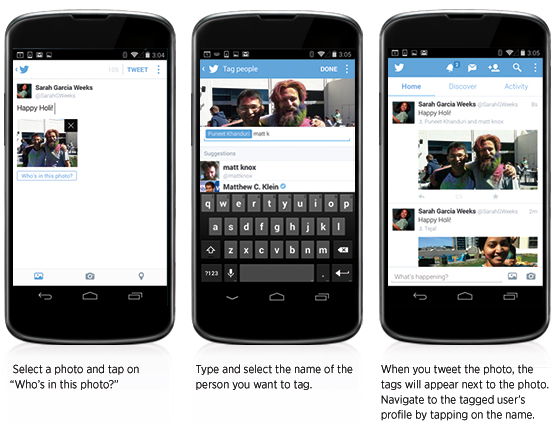Yesterday, Twitter announced two new updates to the way people can use images on the social network. Twitter has now made it possible to upload up to four images at a time. Which might not sound particularly interesting at all, but in fact it has become quite popular for people to upload images to Twitter or Instagram that are actually a collage of different images. Twitter has just made it an easier process now where you no longer have to create these images offsite before uploading. You just upload your four images and Twitter automatically Tweets it out in what appears to be a collage of those images, but each picture actually opens up to its full Twitter size when individually clicked.
But hold on, I did say two updates. Users are now able to tag other users in their photos, up to 10 per photo and they won’t eat into your 140 character limit at all.

Though this capability is currently only available for the iPhone, Twitter has confirmed that it will also be rolled out for the Android app and Twitter website in the near future. Though all users are still able to view the new image features cross platform, without an iPhone. They will also show in embedded Tweets too!
Why Twitter have taken this long to include the tagging feature to begin with is beyond me. It’s very popular with Facebook already and has been for years. But let’s not forget that it’s only been a few months since Twitter first made their Timeline more visual, where people are able to see pictures and videos as they scroll through their feed. The lack of them before didn’t exactly deter potential users from using the service. But I do think that these new features are most definitely going to play a significant role in the way brands and people interact with each other, once people start to familiarise themselves with them across all platforms.
Oh great, another way for Spammers to Spam me…
How long before you get a notification pop up every 10 minutes to tell you that you’ve been tagged in another stupid/inspiring/funny photo of the day? Of course, like on Facebook, you can remove your own tags from images that you don’t want to be associated with. And, of course, Twitter do give you the option to adjust who is able to tag you in images (or opt out altogether) in your privacy settings, allowing you to choose from three different tagging options:
- Anyone can tag you, whether you’re following each other or not.
- Only accounts you follow are able to tag you.
- Disable tagging altogether so that no one is able to tag you at all.
Twitter’s 140 character limit is almost encouraging us to post more multimedia, so that we can communicate our messages as effectively as possible within a single tweet making for more meaningful bite-sized content. Small little pieces of ourselves that we can quickly favourite, share and move onto the next item in our feed. With image tagging, it’s going to make these “come and go” interactions a lot more social.
You know you’re going to be Tweeting a photo of your awesome burger at @AwesomeBurgerBar anyway, so now you can leave out the @mention if you choose, and tag them in the photo instead. Which saves you some characters to really describe your awesome burger experience spectacularly, without having to worry about crediting the awesome bar in your Tweet, and shares your awesome photo with @AwesomeBurgerBar’s followers in their Photos and Videos album on their profile. Everybody wins!
The difficult decision then would be how the brand chooses to use image tagging. If they allow for anyone to tag them, they will need to constantly monitor the material that they are being tagged in to ensure that none of the images can potentially be damaging to their image. And then they have to manually remove the tag if it is. This doesn’t just mean photographs from unhappy customers with uncooked burgers (some brands see this kind of negative engagement as an opportunity to show humility and prove to their fans that they are willing to set things right publicly), but also the trolls who just get a kick out of tagging people in crude images.
Of course by opting out of image tagging altogether, you could be losing out on some great engagement opportunities with your community. Fans might even consider it arrogant that you’re collapsing a bridge between you and them. The same goes if you choose to only accept image tags from users you follow. Something as simple as how a brand chooses to use image tagging can suddenly make or break a marketing campaign, and I will be interested in seeing how both users and brands will be using Twitter’s new image features in the months to come.


This paragraph will help the internet visitors for building up new web site \nor even a weblog from start to end.